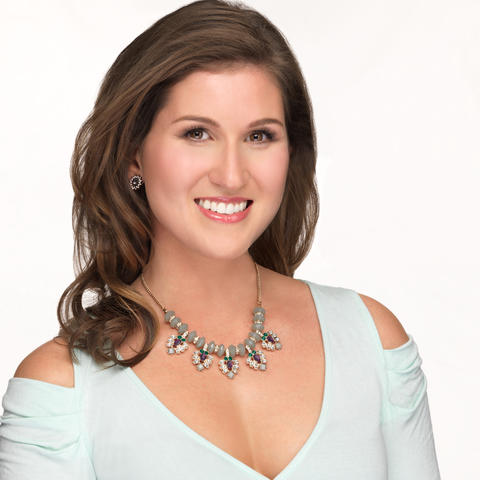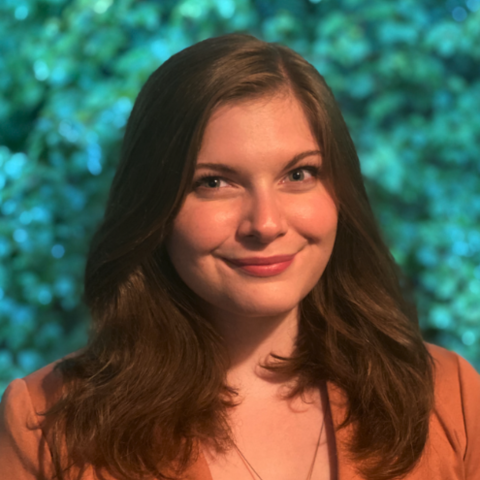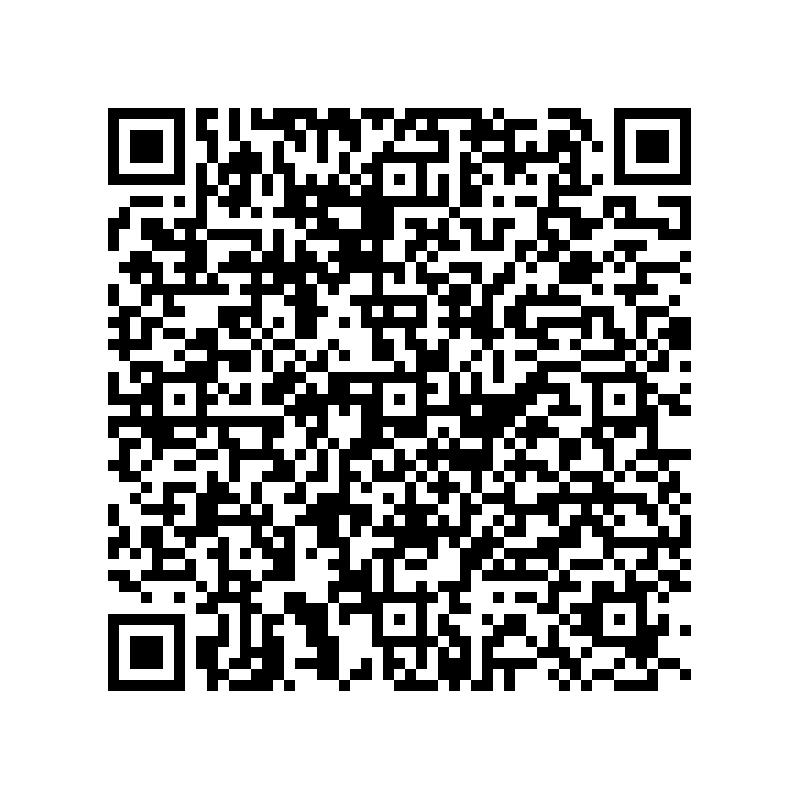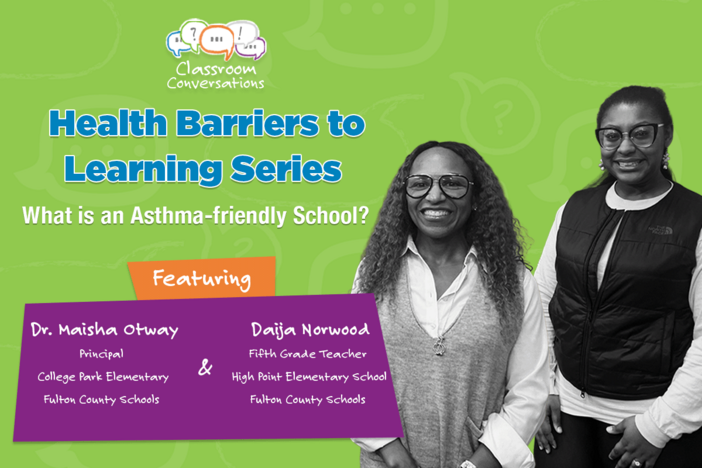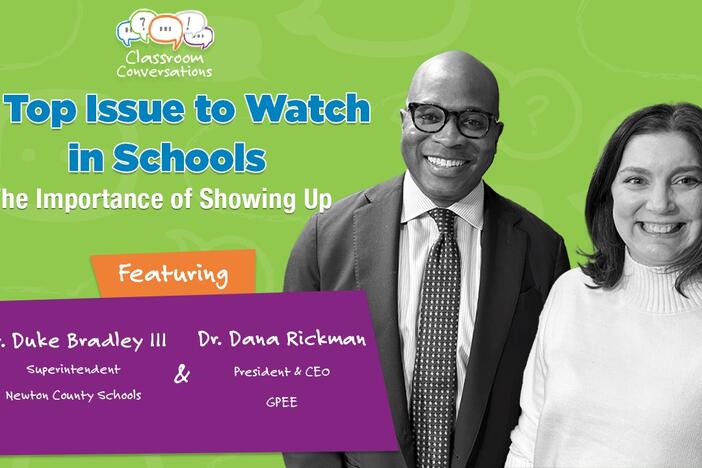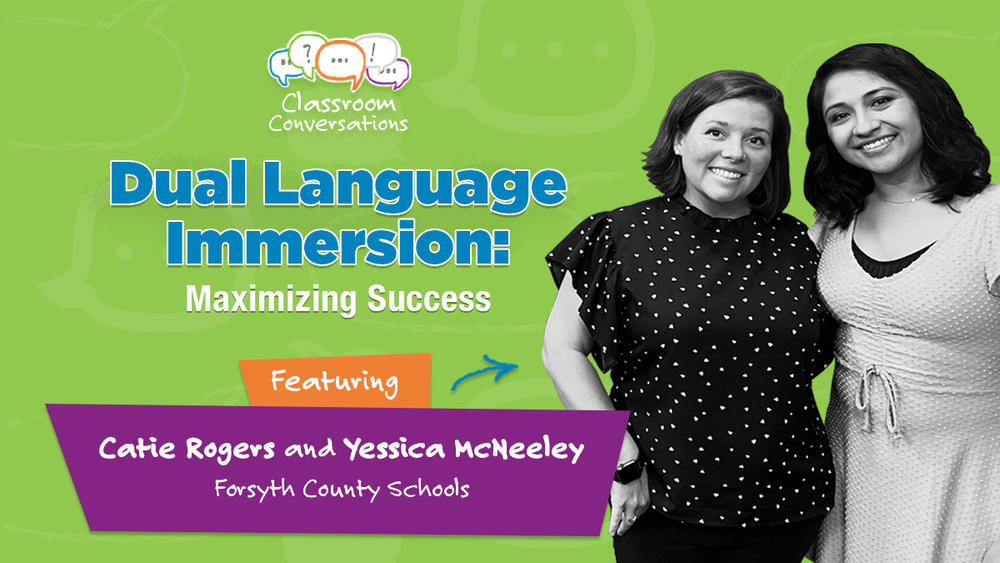
Section Branding
Header Content
Episode 210: Dual Language Immersion: Maximizing Success
Primary Content
Catie Rogers and Yessica McNeeley of Forsyth County Schools talk with us about the educational benefits of Dual Language Immersion.

Catie Rogers and Yessica McNeeley of Forsyth County Schools talk with us about the educational benefits of Dual Language Immersion.
TRANSCRIPT
Ashley Mengwasser: Hello. Hello. Welcome to Classroom Conversations, the platform for Georgia's teachers. This podcast series is presented by the Georgia Department of Education in Partnership with Georgia Public Broadcasting. It's me your host, Ashley Mengwasser here at GPB Studios in Atlanta. Today, we duel. Wait, wait. The other dual. I mean dual D-U-A-L, definition consisting of two application, dual language immersion, or DLI. A wise man named Charlemagne once said, "To have another language is to possess a second soul." At Cumming Elementary School, part of Forsyth County Schools, Catie Rogers and Yessica McNeeley are on a bilingual mission in their kindergarten classrooms where students know them as Mrs. Rogers and Maestra McNeeley. Catie and Yessica are counterparts in the DLI marriage marked by side by side language instruction, and they're here to tell us how this ultimate tag team works. A warm welcome and Bienvenidos to our guests, Catie and Yessica. Hi.
Catie Rogers: Hi.
Yessica McNeeley: Hi.
Ashley Mengwasser: How are you guys?
Catie Rogers: Great, thank you.
Yessica McNeeley: Great.
Ashley Mengwasser: Let's trace it way back and hear your origin story if you will. I want to hear about the planted seeds that blossomed into these two beautiful language teachers. Tell us how long you've been teaching and what brought you each to this particular profession. You first, Catie.
Catie Rogers: Well, I always knew I was going to be a kindergarten teacher before I went to kindergarten, so I've loved school forever. I am originally from Chicago, but went to University of Georgia and got my degree in foreign language education to teach Spanish. But I knew I wanted to teach in the elementary level, so I taught kindergarten through fifth grade Spanish as a specials, which supported their classroom instruction. Then ended up teaching kindergarten for about nine years out in West Georgia. Then when I moved back to Forsyth, moved to Cumming Elementary School and taught fifth grade while the dual language program was starting up, getting started. When the kindergarten English side opened up, I said, "That's what I want."
Ashley Mengwasser: "That's me."
Catie Rogers: Yes, exactly. That's my jam. So combining the language learning and kindergarten is my jam.
Ashley Mengwasser: You jam again, double jam. Yeah. How many years total is that?
Catie Rogers: So, I've taught for 18 years.
Ashley Mengwasser: 18 years. Almost two decades.
Catie Rogers: Yes. I know.
Ashley Mengwasser: It's pretty incredible.
Catie Rogers: It's strange to be on the downhill of the mountain...
Ashley Mengwasser: No, it's not.
Catie Rogers: ... I would say.
Ashley Mengwasser: No. You're still rising. You're still rising.
Catie Rogers: True.
Ashley Mengwasser: Yessica, what about you? How many years teaching and how did you make it here today?
Yessica McNeeley: I've been an instructional assistant for one, and I've been teaching for nine years.
Ashley Mengwasser: So, 10 years.
Yessica McNeeley: 10 years. Yes. I started... When we moved here to the USA, I didn't know any English.
Ashley Mengwasser: From where?
Yessica McNeeley: From Mexico.
Ashley Mengwasser: Oh.
Yessica McNeeley: So, my dad actually brought us here when he finalized paperwork and things like that. I was new and all those teachers that I had prior kind of inspired me to become a teacher. Good and bad teachers, I always say.
Ashley Mengwasser: Of course.
Yessica McNeeley: The good teachers and the bad teachers. So I wanted to grow up and help more children like me. I went to school and I got my bachelor's. Then I got a job as an instructional assistant once I graduated college, because back then, there weren't that many jobs as teachers open as there are now. There wasn't that much of a demand. So I kind of waited at the school I'm in right now for a job to open up as a teacher. But that gave me experience, kind of got my foot through the door there, and then I finally managed to get a fourth grade position. I was in fourth grade, traditional classroom for four years. And I was approached by our principal at the time, Leanne Rice...
Ashley Mengwasser: I you to say Leanne Rimes. I said, "Wow, what a profession change for her."
Yessica McNeeley: Leanne Rice actually approached me and said, "Would you like to start the DLI program? You'd be the Spanish teacher, and I have an English counterpart," which wasn't Catie at the time. It was someone else.
Ashley Mengwasser: Similar thing.
Yessica McNeeley: Yes, and I was ready for that change since I'd been in fourth grade for four years. I was kind of like, "Yes," and I knew nothing about the DLI program. I didn't even know that that was such a thing in Georgia. So we kind of visited schools, immediately fell in love with the program, "Sign me up." I've been with the program in kindergarten for five years now.
Ashley Mengwasser: Here you are.
Yessica McNeeley: Here I am.
Ashley Mengwasser: Beacon of DLI Light, DLI Light.
Yessica McNeeley: Yeah.
Ashley Mengwasser: Well, I'd love to hear a few tidbits about you as people, because I always like to remind ourselves that teachers are individuals too and you're interesting. Yessica, will you tell us a little bit about yourself?
Yessica McNeeley: Something about myself. Right now, I'm teaching my son in DLI, dual language immersion.
Ashley Mengwasser: At your school?
Yessica McNeeley: At my school. I recently had a little girl in January, January 19th. She's seven months. And actually the person I'm married to, we went to elementary school together.
Ashley Mengwasser: Really? That's so rare.
Yessica McNeeley: Yeah.
Ashley Mengwasser: What's your little girl's name?
Yessica McNeeley: Uditsa Everly.
Ashley Mengwasser: Oh, my gosh. And your partner's name?
Yessica McNeeley: Derek McNeeley.
Ashley Mengwasser: And you've known each other all this time?
Yessica McNeeley: Yep.
Ashley Mengwasser: Surely you weren't an item all this time.
Yessica McNeeley: No, not even in high school or middle school. It was just kind of like just you're there. I'm here.
Ashley Mengwasser: Exactly. You knew each other, you know each other.
Yessica McNeeley: Yeah, we knew each other. It totally started after college.
Ashley Mengwasser: That is fascinating. I love that. Okay. How many times a year do you visit Mexico?
Yessica McNeeley: We actually have a house there, so we visit maybe twice, sometimes three times a year, depending on airline tickets and their price.
Ashley Mengwasser: Oh yeah. Big consideration these days.
Yessica McNeeley: Yeah.
Ashley Mengwasser: Where in Mexico?
Yessica McNeeley: Guerrero, Acapulco.
Ashley Mengwasser: Oh yeah. Got my attention.
Yessica McNeeley: Yeah.
Ashley Mengwasser: Catie, how about a few fun facts about yourself?
Catie Rogers: Well, I said earlier, I'm originally from outside of Chicago, but I've lived in Georgia now way over half my life.
Ashley Mengwasser: You're a Georgian now.
Catie Rogers: Yes, I am. And let's see, I locked eyes with Tony Danza at a Ron Clark celebration. A couple years ago, I got to go and he was the keynote speaker and so we made eye contact. That's pretty exciting.
Ashley Mengwasser: What was his visual registering of the eye contact? Do you think it affected him as much as it affected you?
Catie Rogers: He smiled, absolutely.
Ashley Mengwasser: He smiled.
Catie Rogers: Yes.
Ashley Mengwasser: He said, "That woman is a true fan."
Catie Rogers: Very happy. “She is a teacher.”
Ashley Mengwasser: "She must be a DLI teacher."
Catie Rogers: Yes.
Ashley Mengwasser: Do you think he knows about DLI? Probably not.
Yessica McNeeley: No.
Catie Rogers: Maybe after this.
Ashley Mengwasser: Maybe... Someone get this to Tony Danza.
Yessica McNeeley: I'll join you.
Ashley Mengwasser: I love it. Any other fun facts?
Catie Rogers: Well, I was just going to say, I met my husband in business Spanish class at UGA.
Ashley Mengwasser: Business Spanish class?
Catie Rogers: Yes.
Ashley Mengwasser: What does that mean?
Catie Rogers: Well, we had to learn how businesses conducted in different Spanish-speaking countries.
Ashley Mengwasser: Oh. Interesting.
Catie Rogers: Which was basically an interesting Spanish class for me to take because I was education all the way.
Ashley Mengwasser: Correct. Is business conducted in Spanish-speaking countries similarly to the United States?
Catie Rogers: It is. We had to learn about different tendencies or commonalities between different countries basically. Like in España, they have siesta. So you don't plan a business meeting between 2:00 and 4:00.
Ashley Mengwasser: That is my favorite tradition of any culture ever is Siesta, honestly.
Catie Rogers: It is. I wish we still had it in kindergarten sometimes. Yeah.
Ashley Mengwasser: Your teachers are taking a siesta right now. Can one of you define for our audience, preferably in English, what is DLI? Give us your understanding as teachers.
Catie Rogers: Sure. Dual language immersion is for us, our particular structure and program is where we have students whose first language are English and students with first language in Spanish. And we each have a homeroom class of 25 students with mixed languages, English and Spanish. And the students spend about 50% of their day in English and 50% of their day in Spanish.
Ashley Mengwasser: That's how it works at your school.
Catie Rogers: Yes.
Ashley Mengwasser: Why did your school implement DLI initially?
Catie Rogers: Well, we have a strong Hispanic community in Cumming and it's a very beneficial and effective ESOL teaching program style of teaching.
Ashley Mengwasser: Good point.
Catie Rogers: And so, in an effort to maximize the success of our students and our school, dual language was a really positive opportunity.
Ashley Mengwasser: It was. What is that population, percentage-wise, of Spanish speakers?
Yessica McNeeley: I would say over 60%.
Ashley Mengwasser: Over 60. More than half, approaching three quarters. That's really interesting. And how does this dance work between the two of you? Talk a little bit about the characteristics of the DLI marriage and the teacher side by side model. You want to take this one, Yessica?
Yessica McNeeley: Well, first of all, our classrooms have to mirror each other.
Ashley Mengwasser: Okay.
Yessica McNeeley: Basically, the way we set up our tables, her tables have to be set up in a similar way, mirroring what I did...
Ashley Mengwasser: In your classroom.
Yessica McNeeley: ... in my classroom. The kids sit in the same spots when they're with her, they sit in the same spots when they're with me. Let's say we have our tables red, green, yellow. So those children that sit in the red, green, or yellow would come to my classroom and sit in the same tables, which makes it a lot easier with me having to explain it in Spanish. So she does it in English, I do it in Spanish, but they kind of like, "Oh, this is what we do in Ms. Rogers class."
Ashley Mengwasser: Okay.
Yessica McNeeley: So, a lot of planning is done between her and I. Whether I want kids to understand, "¿Cómo estás?" I'll say, "Mrs. Rogers, this is what I'm using as teaching them that phrase. Can you use this, but replace the Spanish with English instead?" So there's a lot of communication between her and I with subject and content areas, math, social studies, science, because she only teaches social studies reading and morning message. Within her morning message, her morning meeting is the number talks, which is her math. For me, it's math, science, and Spanish language arts as well.
Ashley Mengwasser: I gotcha. I think I understand. And kind of sitting the same physical space...
Yessica McNeeley: Yes.
Ashley Mengwasser: ... helps them bridge the language gap there.
Yessica McNeeley: Yes.
Ashley Mengwasser: They're learning from one to the other.
Yessica McNeeley: Yes.
Ashley Mengwasser: That's a really smart idea. What about more on the physicality of it? Are you guys in two separate classrooms physically?
Yessica McNeeley: Yes, we are physically. So the students, I have a homeroom. She has a homeroom. We switch in the middle of the day.
Ashley Mengwasser: Are those far apart, your home rooms?
Yessica McNeeley: No, they're right across each other.
Ashley Mengwasser: I get it.
Yessica McNeeley: Yeah, in the same hallway right across each other.
Ashley Mengwasser: So, they literally walk into Spanish and walk into English.
Yessica McNeeley: Yes, and we even have a little science that say Español and English.
Ashley Mengwasser: Isn't that just the spatial representation of fluidity? What you guys have just done right there in terms of the language instruction you're doing? Tell me about the benefits of the dual language immersion program.
Catie Rogers: Well, we think there are many, many benefits, but being able to strengthen and support our Spanish speakers and learning Spanish as their first language, as well as opening the doors for our English speakers to be learning a second language, both groups are learning a second language. So the learning of one language can facilitate the learning of the second language, which studies have shown that it increases language ability to learn a second language.
Ashley Mengwasser: It's a leg up. That's interesting.
Catie Rogers: Right, and then with the end goal in mind that we have bilingual, bicultural, biliterate people, teens graduating from high school and then going on into college being bilingual, bicultural, and biliterate.
Ashley Mengwasser: I like that. The triple bi method.
Catie Rogers: Yes.
Ashley Mengwasser: You've got bilingual, bicultural, and biliterate. And define the three of those separately. We know what bilingual means, fluent in two languages.
Catie Rogers: Right, speaking-wise. Biliterate would be reading and writing in both languages and then bicultural would be understanding and being a part of more than one culture.
Ashley Mengwasser: Okay, so it's more than just...
Catie Rogers: Awareness.
Ashley Mengwasser: ... just a distant appreciation of. You actually really immerse yourself in the culture while learning the language. Yessica's nodding. Anything to add there?
Yessica McNeeley: I would say we kind of harvest the original language. For a lot of my Spanish speakers, they kind of lose that opportunity of speaking Spanish at school. But in a dual language program, they have more of the ability to show off both their Spanish and English speaking abilities. And for the English speakers as well, that some of them come to me without a single parent or relative speaking Spanish. They as well kind of love learning the Spanish language as well. So they kind of gain an appreciation for the Spanish language.
Ashley Mengwasser: And from your standpoint in front of the classroom, what do you think are the rewards and the challenges of educating in two different languages?
Yessica McNeeley: So, for me, rewards, I'll talk about the rewards, and you can talk about the challenges. Rewards for me would be watching them learn, watching them use the languages, both of them. Especially for students who might come with zero English, watching them make the connections between Spanish and English and hearing their English teacher telling me, "Oh, he spoke of a complete phrase today." That's what we want our ESOL kids to be doing is learning English. But at the same time, they're still learning how to read and write in Spanish. For my English students too, one of the biggest rewards is watching them just learn and enjoy learning a second language.
Yessica McNeeley: I would say those are the biggest rewards. Watching the kids... I'm the kindergarten teacher, but then their first grade teacher gets that group, so I get to keep track of them as they go through K, one, two, three, four, and five. So I can always talk to their first grade teacher and ask, "How are they doing? Are they speaking more Spanish?" Or, "How are they doing in math? This subject area." That's always been one of the rewards that we can always check up on them, I guess, on the students.
Ashley Mengwasser: Yeah, follow their progress.
Yessica McNeeley: Yes. Follow their progress throughout. So that would be one of the biggest rewards.
Ashley Mengwasser: Those are excellent. And challenges, Catie?
Catie Rogers: Challenges. Well, there are a few, but I definitely think the rewards outweigh the challenges.
Ashley Mengwasser: Oh, naturally.
Catie Rogers: But as Yessica was saying, the kindergartners are coming in. No matter what language they have at home, they're all learning how to be kids and how to be friends and how to be students, how to listen, how to control, have self-control, and pay attention, and try. So the range of background experience or schooling experience or family support that we have, it goes across the board and that's typical of most kindergarten. You have students that are coming in with a lot of knowledge and some coming in as blank slates. So figuring out how to meet all of those needs can be a bit of a challenge. Then for me, if it's a Spanish speaker, I stay strictly in English and Yessica stays strictly in Spanish in her classroom. So getting the students to feel comfortable communicating can be a little tricky at the beginning. So we use different hand signals for students to express what they need for in my classroom and then the same ones in Yessica's room and keeping the structures exactly the same as far as Yessica doing the Spanish language arts and me doing English language arts. We do our read aloud that focuses on vocabulary and our shared reading and phonics. Keeping those things in the similar format...
Yessica McNeeley: That's a challenge.
Catie Rogers: ... is a challenge to start with, but once...
Yessica McNeeley: Getting it all in too.
Catie Rogers: Exactly.
Yessica McNeeley: Because it's half a day.
Ashley Mengwasser: Oh, yeah.
Catie Rogers: Yeah, we have twice as many students and half the amount of time with those kids.
Ashley Mengwasser: I see.
Catie Rogers: But taking that time and planning together and supporting the kids learning on both sides, English and Spanish, it pays off.
Ashley Mengwasser: Like you said, the positives outweigh the logistics you have to consider.
Catie Rogers: Right. Yes, it's a little learning curve to make it happen and get those routines and structures set.
Ashley Mengwasser: Can you think of a representative story about a student who really thrived in DLI? You may have more than one.
Catie Rogers: I mean, I think about a little boy, Arone, who came in with no English and he would say, "No habla inglés," at the very beginning. But then I'd watch him and he'd soak it in. He was paying attention. I just remember when he stood up during shared reading and said, "I can read it! I can read it!" He pointed to each word and tracked it and read it and he was so excited.
Ashley Mengwasser: What confidence. And these are kindergartners.
Catie Rogers: Right.
Ashley Mengwasser: They're young.
Catie Rogers: They're young.
Ashley Mengwasser: Do you have a story, Yessica?
Yessica McNeeley: I have a student who, a girl, she's in fourth grade right now and I could just tell she was super enthusiastic about Spanish, and she still visits me down in kindergarten from her fourth-grade classroom, from her fourth-grade life. She'll come down and she's speaking to me in full phrases in Spanish and sometimes I'll catch up with her teachers and they're like, "She's doing wonderful."
Ashley Mengwasser: I bet that is so affirming for you guys...
Yessica McNeeley: Yes.
Ashley Mengwasser: ... to see they laid that foundation in your classrooms. Why should schools look into DLI as a model?
Yessica McNeeley: I think it's great for developing, like Catie was saying, cultural awareness as well, language awareness as well, and for students who want to learn a second language or want to continue to harvest their first language. I think it's great for ESOL students. There are some schools, our school's Spanish, but there are some schools that DLI program based on what the community speaks most of. I've heard schools in Gwinnett who do a Korean dual language program...
Ashley Mengwasser: Oh, wow.
Yessica McNeeley: ... or French dual language program. So I'm only familiar with the Spanish because I teach it. But I know there's other schools who will do a DLI program based on the majority of their ESOL population.
Ashley Mengwasser: Right.
Yessica McNeeley: So, I think it's a great way for schools to implement an ESOL program that is effective. It's shown to be effective.
Ashley Mengwasser: And early.
Yessica McNeeley: Right.
Ashley Mengwasser: Students don't know it yet because when they get to be our age, they're going to wish they had that. We were just talking about that before we started is can you imagine if this was our foundation?
Catie Rogers: Exactly. That's why I was going to say, the earlier you start language acquisition and learning a different language, the better off you'll be. I wish I had started Spanish.
Yessica McNeeley: We do have some students that, for example, this year we have some students who are learning a third language.
Ashley Mengwasser: Oh.
Yessica McNeeley: We've got some students who their first language is Russian, their first language is Portuguese, their second language is English because maybe they attended an English Pre-K.
Ashley Mengwasser: Okay.
Yessica McNeeley: So now they're adding Spanish into the mix and that would be their third language.
Ashley Mengwasser: They're going to be trilingual.
Yessica McNeeley: Right.
Ashley Mengwasser: That's amazing. Is there anything you wish you'd known when you first started teaching in the program?
Yessica McNeeley: With the Spanish teacher, I was all for it, but I wish somebody had told me how much of the things, materials, activities I would be creating on my own. Because there's a plethora of English materials out there, but not so much Spanish or at least to make it for my classroom. Maybe I'll find something, but I'm like, "This doesn't really fit my classroom," so I'll have to make it on my own. I don't really have a team that I can say, "Hey, do you have this activity for this?" I kind of have to create it on my own.
Ashley Mengwasser: You have to produce those lessons. Yeah. What about for you, Catie? What do you wish you'd known?
Catie Rogers: Well, I guess I would, thinking back, I wish I knew how big of a challenge it is to have 50 students and 50 sets of parents to communicate with and care about. It's a lot of kids back and forth and like we said, half the amount of time. So you really have to make sure you use every minute that you have with the kids and be very organized and very prepared. That's very important.
Ashley Mengwasser: Well, if you do optimize that time, that one minute could be their aha moment.
Catie Rogers: Absolutely.
Ashley Mengwasser: So much can happen in a minute, or a new word is mastered.
Catie Rogers: Right.
Ashley Mengwasser: For any detractors of this who might say as adults, again, we're just projecting onto the young learners, but "Isn't it kind of hard to learn a new language and isn't that a burden for the child or another obstacle for them?" What do you say to that kind of myth of, you're saying starting early is really the best thing, but do the kids seem enlivened by it or how do they react?
Catie Rogers: I mean, kids are resilient. I think some kids may have a little apprehension or nervousness, but I think once they figure out that everyone's learning in kindergarten and the teacher makes mistakes too, so what can we do? We fix it and keep trying. I think it builds their confidence...
Ashley Mengwasser: Yes.
Catie Rogers: ... to be able to take risks and we try and use strategies that really help with them feeling confident and assured, part of keeping the routine the same on both sides so that they have a context to put the new vocabulary or the new sentence stem or the new language structure that we're teaching.
Ashley Mengwasser: The structure never fails them. So really the only obstacle you might see if there is any reticence is just their own self-consciousness as kids. And you help them over that by teaching them, having these systems in place that make them more confident.
Yessica McNeeley: It's actually funny that Catie's talking about that because when I first started DLI, I thought they would be crying more because I'm speaking Spanish.
Ashley Mengwasser: Yeah.
Yessica McNeeley: I was inexperienced, and I didn't know what to expect. But I would ask my partner, I'd be like, "Can you ask them like is it because I'm speaking Spanish? Is that why they're crying?" Then she'd come back to me and be like, "No, they miss their mommy."
Ashley Mengwasser: Oh.
Yessica McNeeley: I'm like, "Okay. It's not because speaking Spanish."
Ashley Mengwasser: It has nothing to do with DLI.
Yessica McNeeley: Yes. But I would say that some, DLI isn't for everyone. Of course, there have been some students that just weren't interested.
Ashley Mengwasser: Okay.
Yessica McNeeley: They were not interested in the language piece of it. And that's when we have to get together with the parents and let them know our concern for their child. Because our end goal is that we want each child to do good in school, whether it's in DLI or in a traditional classroom.
Ashley Mengwasser: Right. Which begs the question, is this then at your school, an opt-in sort of program?
Yessica McNeeley: It's based on a lottery, but you do have to kind of sign a contract saying you will be committed to the program if you're interested in the program.
Ashley Mengwasser: I see. And then if it needs to be reevaluated, you talk to the parents and you make a decision about what's best for each student.
Yessica McNeeley: Yes.
Ashley Mengwasser: Got it.
Catie Rogers: And parents do because we do want students to be invested and committed to the program.
Ashley Mengwasser: Right.
Catie Rogers: Parents do have to read our commitments and sign off on them. The end being the students participating all the way, middle school and high school.
Ashley Mengwasser: Yes. That is the vision. How about some DLI 101? What are some tips that you would like to share with our educators listening, whether DLI is a formal program at their school or not?
Catie Rogers: I think one of the strategies we use all day, every day would be SIOP. It's sheltered instruction observation protocol. The words don't really make sense to what it is.
Ashley Mengwasser: They don't, do they?
Catie Rogers: It's basically sheltered, meaning it's very specific to the content, like specific content vocabulary, instruction, meaning you're teaching the words and the word language, the meaning of the word. And then observation protocol is basically doing a motion to go along with the word, physicality, motions, hand motions, and TPR, total physical response, which with new vocabulary words, we always use emotion and we always attach it with a graphic or a visual to help them retain the vocabulary.
Ashley Mengwasser: Can you give us an example?
Catie Rogers: Well...
Ashley Mengwasser: Physically?
Catie Rogers: What's my voc... Oh, our signal's like using the bathroom or I need help. We have to tell the cafeteria monitors every year that this means, "I need help."
Ashley Mengwasser: The gesture with the arms crossed in front of the face means I need help.
Catie Rogers: Right. You might not hear them, they may not say what they need, but this is what they're...
Ashley Mengwasser: They know what they're communicating. Other tips?
Yessica McNeeley: I would say something that, one of the things that I took from DLI was the importance of the I do, we do, you do. Which is basically, if I'm teaching, let's say addition, the teacher would model it twice, then she would call on the student maybe two times, maybe even three, a different student each time, to practice the same activity as the teacher using the same materials. And then you do would be, everybody else gets their turn at their tables and does the exact same thing.
Ashley Mengwasser: After they've seen it multiple times.
Yessica McNeeley: After they've seen it multiple times. And I mean, that's just amazing is that who really needs help, I guess support, and who has got it. And you might need to give them a little bit more of a challenge.
Ashley Mengwasser: Yes.
Yessica McNeeley: So that really does help the I do, the we do, the you do.
Ashley Mengwasser: Yes. Okay. Well, before we close this out, I'd love to hear just a last bit of wisdom from each of you. What is your favorite thing about being a DLI teacher?
Yessica McNeeley: I love being able to reach several students. Like she said, we have 50, and it is a challenge, but I love having 50 students.
Ashley Mengwasser: More students who are becoming bilingual, bicultural, and...
Yessica McNeeley: More students are becoming bilingual. Yeah. I just like getting to know them, getting to know their little personalities. Yeah.
Catie Rogers: That's funny because that's exactly what I was going to say. I love all the kids. I mean, we're in it for the kids and to see them grow from the beginning of the year, that's a bit of a struggle to... Because as teachers, you get used to students being able to do things independently or...
Yessica McNeeley: Yes.
Catie Rogers: ... they get used to it and then the year they move on, the year ends and then a new year begins and it's like back at square one.
Yessica McNeeley: Yes.
Catie Rogers: But to see how much they grow from August all the way to May is amazing every year. It's miraculous.
Yessica McNeeley: Yeah. If you were to see the kindergarten classroom the first three weeks...
Ashley Mengwasser: Wow.
Yessica McNeeley: Yeah. It makes us be so exhausted.
Ashley Mengwasser: Yes.
Yessica McNeeley: The kids too. But towards the end of the year, it's kind of like, "Ah, they've got it."
Ashley Mengwasser: Look at what we did.
Yessica McNeeley: Yeah.
Ashley Mengwasser: That is the satisfaction of the pilgrimage, right?
Catie Rogers: Yes.
Ashley Mengwasser: Well, DLI is definitely the future, and for good reason. Dual language immersion gives students a wider, deeper perspective of the world. It's the beauty and the meaning of life doubled with exposure to and mastery of a second language. So thank you, Yessica, thank you, Catie, for being here today. Any final words?
Catie Rogers: Thank you for having us.
Yessica McNeeley: Have a great school year, everyone.
Catie Rogers: Yeah.
Ashley Mengwasser: That's awesome.
Catie Rogers: Good luck.
Ashley Mengwasser: Thank you for joining us for another intriguing episode, everyone. As you go, make bilingual learners and here's something that's true in every language, you're a great teacher. Talk to you next time on Classroom Conversations. Bye-bye. Funding for Classroom Conversations is made possible through the School Climate Transformation Grant.
Catie Rogers and Yessica McNeeley of Forsyth County Schools talk with us about the educational benefits of Dual Language Immersion.

